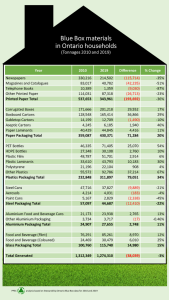An analysis of the last 10 years of data on Blue Box-type materials generated by Ontario households shows a 34% increase in the amount of plastic packaging ending up in the home. And most of it (70%) did not get sent on for recycling.
The major increase is in the catch-all category of “other” plastics, things like yoghurt containers, hand cream tubes, margarine tubs and lids, blister packaging for toys and batteries, egg cartons, and laundry detergent pails. The amount of “other” plastics in the home increased by 67% between 2010 and 2019. There have also been big increases in the tonnages of PET drink bottles (up 54%) and mostly non-recycled plastic laminants (up 30%). Other materials to register significant increases over the period are aseptic cartons (up 46%), boxboard cartons (up 29%) and coloured glass (up 25%).

What is missing from Ontario homes compared to 10 years ago is a lot of paper, almost 200,000 tonnes of it. Most of this is newspapers no longer being published (generation is down 35%), but telephone directories, magazines and catalogues, and printing and writing paper have also taken a big hit (down 87%, 51%, and 23% respectively).
These changes in what Blue Box materials end up in the home impact how much is recovered for recycling (Ontario’s Blue Box recovery rate has dipped below the provincial target of 60% for the first time since 2005); and how much the recycling system costs. For example, most paper packaging is recyclable and relatively cheap to recover. Plastics packaging, on the other hand, is currently not widely recycled at all (only 31% in 2019 compared to paper’s 68%) and is two and a half times more expensive to recycle. But that subject deserves a blog all by itself!
